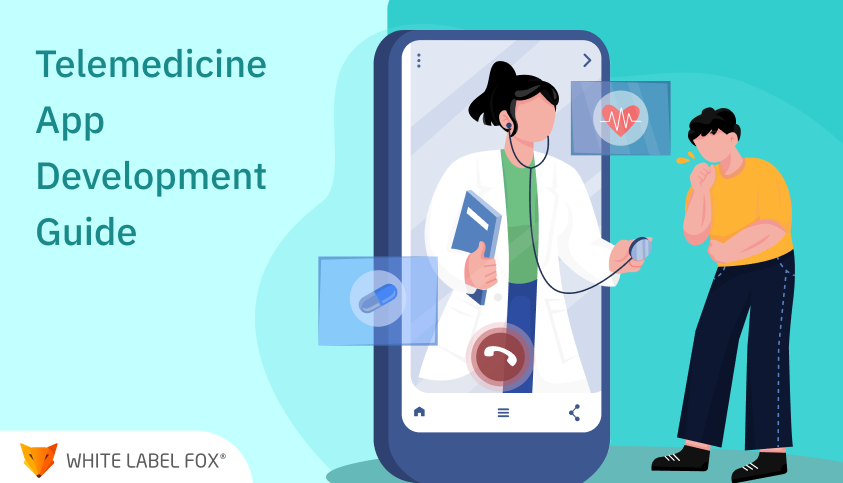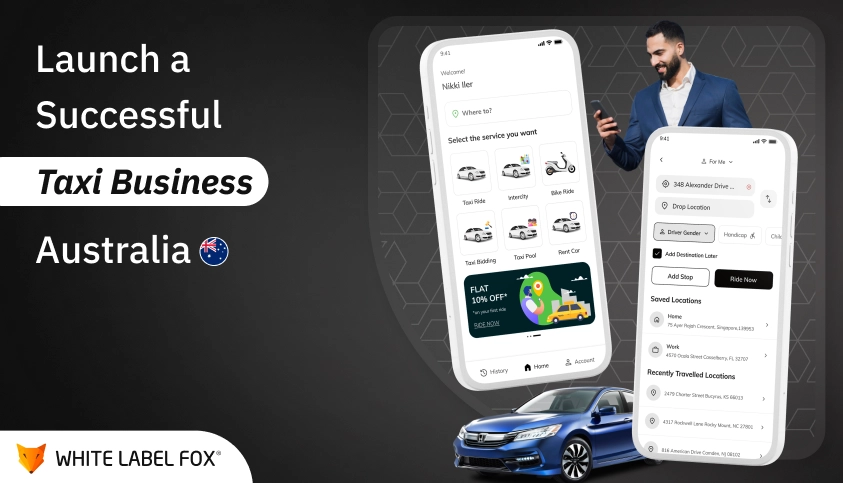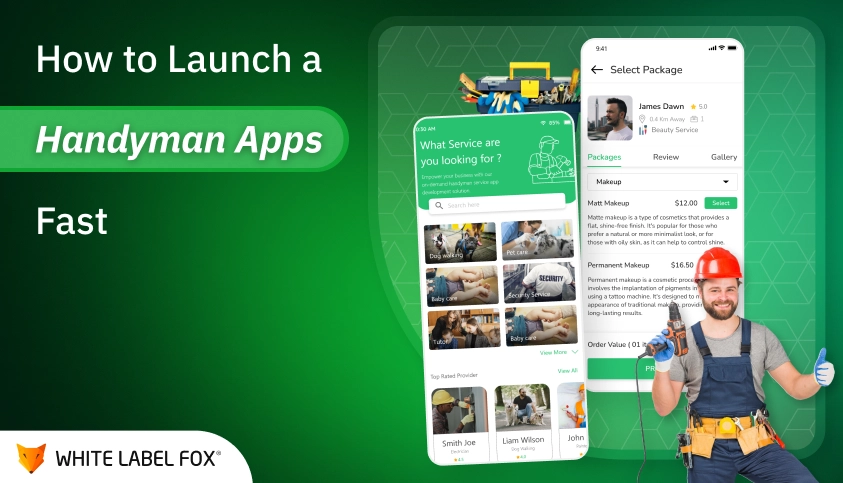The present digital generation has driven innovations that have profoundly changed the delivery of healthcare services, and the emergence of telemedicine is a clear example of this turmoil. The Global telemedicine market size in 2020 was above $50 billion and is forecasted to increase and exceed $286.22 billion by 2030, which illustrates the vast potential and requirement for telemedicine services near the globe.
This growth is exponential because of factors such as the rising number of smartphone users, better internet connectivity, and the necessity of healthcare centres, at least in places seen as remote or underserved.
For now, growing the telemedicine market is the primary selection of healthcare providers, entrepreneurs, and developers, but understanding how telemedicine app development works is becoming necessary. In this comprehensive guide, we look at a custom telemedicine app’s features, costs, and dev (development) process, providing you with the understanding and wisdom you need to succeed in this fast-growing and dynamic industry.
In this blog, we will look at those notable features that are decisive in making white-label telemedicine apps efficient and user-friendly. We will also discuss the telemedicine app development cost and finally outline the process of moving from conceptualization to deployment. Regardless of whether you’re a healthcare professional looking to integrate telemedicine into your practices or an entrepreneur planning to develop a healthcare app, we will show you all you need to know in detail.
Empower Your Conventional Healthcare Business with Right Technology Partner

What is a Telemedicine App?
A telemedicine app is a mobile application by which healthcare providers and patients can communicate remotely via the Internet through video conferencing, messaging, and secure data transfer. This app will facilitate patients to avail medical services through them so they can receive diagnoses, prescriptions, and advice from healthcare professionals without visiting a clinic or hospital.
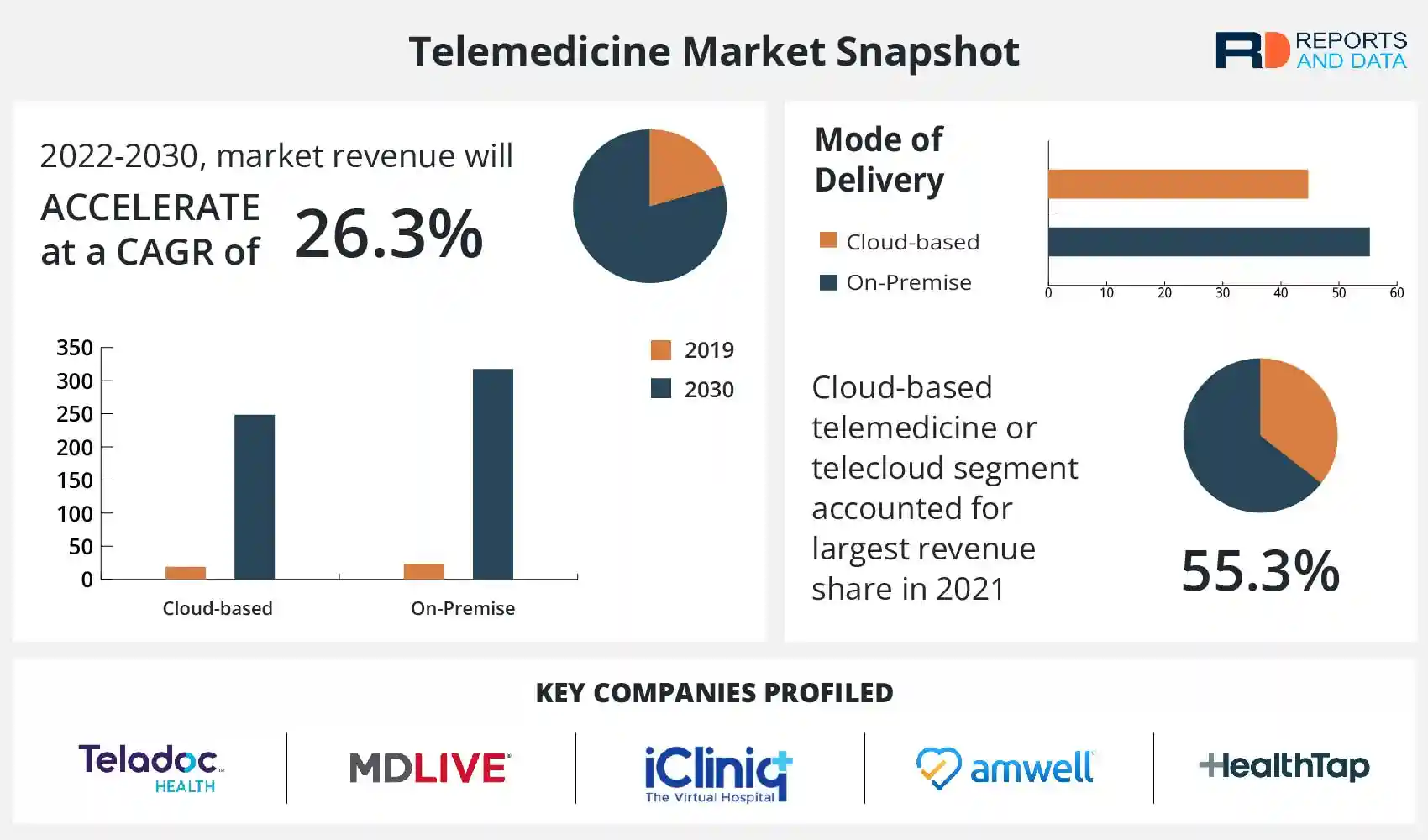
Source:
Reports and DataThe healthcare market is revolutionized by telemedicine apps that knock on the doors to geographic barriers and medical care’s reachability.
Another example is a patient living in a remote region lacking adequate healthcare facilities and can access a telemedicine app to have conversations with a doctor, for instance, in another town or country. Not only does it cut out commuting time and save transportation costs, but it also provides patients with a prompt response and helps to ease the burden of overstretched medical systems.
Additionally, telemedicine apps are:
- An effective platform for consistently monitoring chronic diseases.
- Providing follow-up consultations.
- They are even engaging patients with better health outcomes in mind, which increases the efficiency of the overall healthcare system.
How Does Telemedicine App Work?
Telemedicine app development services provide go-ahead solutions for tailored platforms and engendering smooth and effective workspace for remote health consultations. The apps use advanced technologies, such as video conferencing, secure messaging, and data sharing, to reach out to healthcare providers and patients that aim to facilitate access to medical services anywhere.
Patient Registration and Profile Creation
- Telemedicine usually starts with patients registering on the telemedicine app by sharing essential information and creating a profile.
- It means that medical data is safely confined and thus readily available for review.
Appointment Scheduling
- The app provides patients with a scheduling feature to arrange appointments with healthcare providers at their convenience.
- Patients can select the date, time, and type of virtual appointment they may need and the available time slots scheduled by healthcare professionals.
Virtual Consultation
- For a virtual consultation, patients can use a video call or secure messaging within the app as the scheduled appointment time is reached.
- Within the consultation framework, one can cover the symptoms, get m,vice, and issue pre,nandonline if the necessity arises.
Medical Records and Data Sharing
- Telemedicine apps can often display medical documents uploaded historically, test results, and other medical documents safely and securely for healthcare providers.
- This enables people to be knowledgeable and the whole healthcare process during the virtual consultations to flow smoothly.
Prescriptions and Follow-up
- Once the consultation is over, and if any medications are prescribed, the telemedicine app may create electronic prescriptions that patients can submit at their desired pharmacies.
- Moreover, the app may include other features such, suchaking appointments that will facilitate the continuity of care and follow-up care.
Through digital platforms for telemedicine, patients enjoy the convenience of instant communication with doctors, regardless of their location. Moreover, telemedicine app features such as instant chat, quick response, etc., ensure timely and high-quality medical care.
End-to-End Telemedicine App Development Process
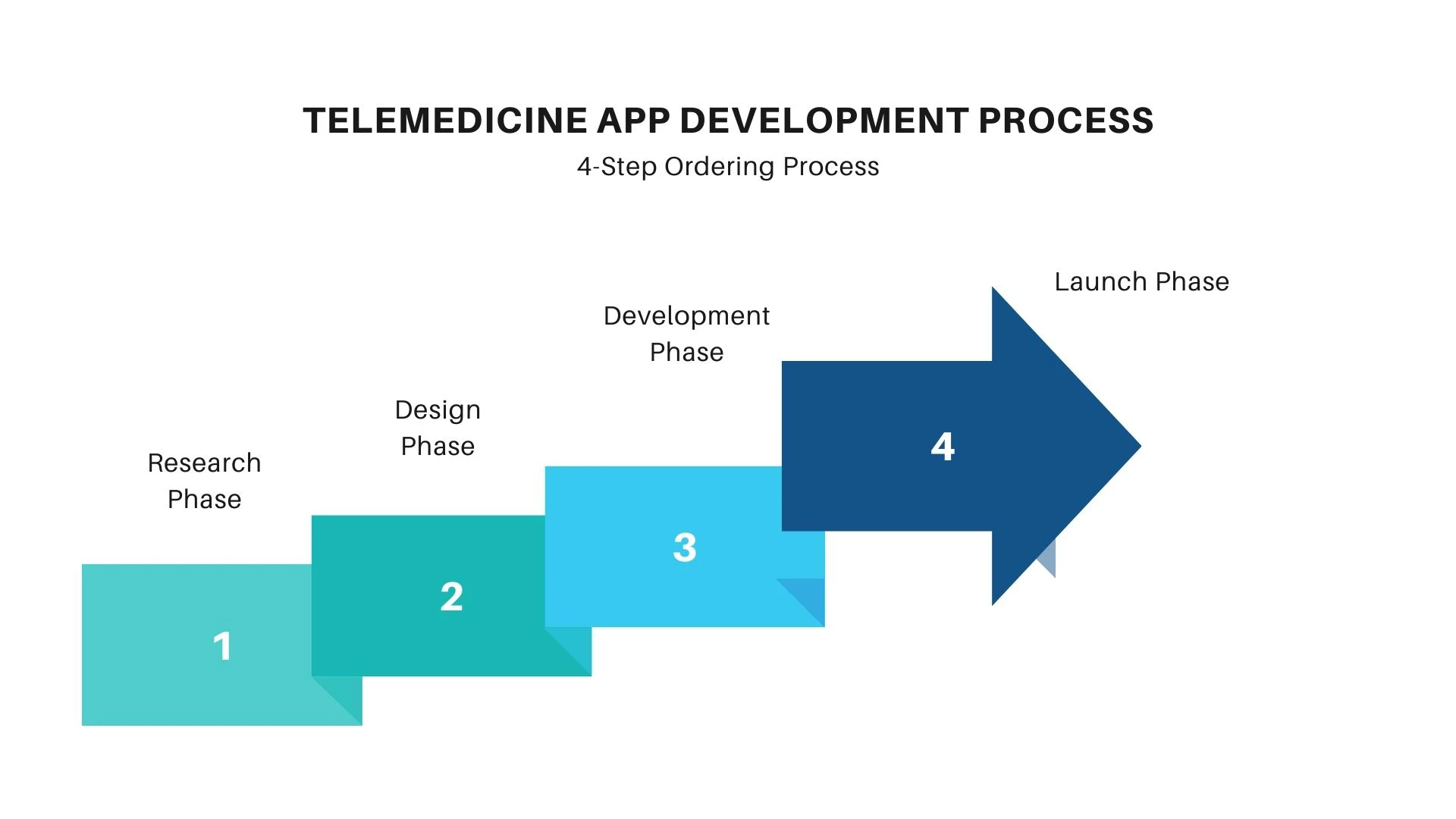
Telemedicine app development services include a full-cycle process, such as creating cutting-edge digital facilities, which transform the accessibility of healthcare services. From the inception of the project and design processes to the development and launching phase, every stage is thoroughly planned so that the user experience is seamless and the provision of medical services is booming.
Research Phase
- Conduct thorough market research to know customer pain points, courses providers have, and new trends in telemedicine.
- Explore competitor offerings and industry benchmarks to grasp where gaps in the market exist as well as the potential.
- Research legal requirements, such as HIPAA compliance, to be sure the sensitive data security standards are up to par.
Design Phase
- Develop wireframes and clickable prototypes to help visualize the app interface, behavior, and essential functionalities.
- Make the design of the user interface (UI) user-friendly, which targets the availability, accessibility, and smooth navigation of patients, doctors, and administrative personnel.
- Integrate telemedicine app features such as medical appointment scheduling, secure messaging, video consultations, electronic prescriptions, and electronic medical record access.
Development Phase
- Decide between either building a custom telemedicine app or using a white-label solution based on price, timing, and the extent of customization needed.
- Add sturdy security functions, such as thorough end-to-end encryption, user authentication, and HIPAA-compliant data encryption and transmission.
- Make backend infrastructure for data storage, appointment booking, payment processing, and health records integration with an electronic health record (EHR) system.
- Add onto the features of telemedicine like real-time chat option, video-conferencing, patient monitoring, and virtual waiting room to improve user experience and clinical efficiency.
Launch Phase
- Implement extensive testing, and make sure that the functional, usability, performance and security tests are performed and the problems and bugs are identified and resolved.
- Develop an app that is optimized for various devices (mobile, tablet, desktop). Also create different versions of the app that are compatible with different operating systems (iOS, Android).
- Design a strategic marketing and promotional plan to raise public awareness, attract patients, enlist healthcare professionals, and stimulate app downloads.
- Provide healthcare professionals with the relevant training and support to innovate the usage and implementation of the telemedicine platform.
During the development phase, custom telemedicine and white-label apps must be specified based on a range of factors such as budget, schedule, capacity, and personalization. While custom apps offer unique solutions and robust customization options, white-label telemedicine apps can function as affordable and well-built alternatives with numerous predefined functions available right out of the box and quicker deployment options, which are most suitable for startups and small healthcare organizations.
Must-have Features to Consider for Telemedicine App Development
Integrating modern features in telemedicine app development results in an easy user experience for patients, optimizing workflows and increasing the efficiency of healthcare providers.
By developing features to address all stakeholders’ needs, such as patients, doctors, and healthcare administrators, telemedicine upgrades healthcare services will improve accessibility, quality, and outcomes.
Telemedicine App Features for Patients:
- User-friendly Interface: Intuitive design with ease of navigation and access to the prominent functions.
- Appointment Scheduling:Book a virtual consultation with the practitioners of your choice without any trouble.
- Secure Messaging: Medical information and inquiries sharing is a type of private and encrypted communication channel option between users.
- Virtual Consultations: High-caliber video teleconferencing for immediate consultation and collaboration with health care practitioners.
- Medical History Access: Personalized health records including test results and medication history can be accessible securely.
- Prescription Management: Digital prescriptions and medication reminders for improving medicine compliance.
- Feedback and Ratings: Feedback and rating capability will be provided to the healthcare services which the customer has received.
Telemedicine App Features for Doctors:
- Electronic Health Records (EHR) Integration: Seamless interoperability with the EHR systems should be the pillar of the development for easy access to patient information.
- Appointment Management:Scheduling, re-scheduling, and cancellation handling procedures for virtual consultations should be designed efficiently
- Teleconsultation Tools: Diagnostic methods, online examination assistance, and data transmission with an expert in real-time are some of the key features of such hospital devices.
- Secure Communication: HIPAA-compliant messaging and file sharing through which patient-physician information can be exchanged confidentially.
- Prescription Generation: Digital protocol development, medication management and pharmacy integration.
- Telemedicine Notes: Documenting and filing telemedicine records as part of comprehensive patient management and to meet compliance standards.
- Analytics and Reporting: Data analytics tools including ones that monitor patient outcomes, performance metrics and insightful data on practice growth.
Telemedicine App Development Cost (Costing Estimation)
The cost of developing a telemedicine app may range considerably, as it will depend on many factors that will adversely influence the development budget.
Below are key factors to consider when estimating the cost of developing a telemedicine app:
| Factors Influencing Cost | Description |
|---|---|
| App Complexity | The array of features and functionalities that must be provided, may include appointment scheduling, video consultations, secure messaging, and EHR integration as well as AI-powered instruments. |
| Platform Compatibility | The costs for development across various platforms (iOS, Android, and the web) are higher than for a solution covering one platform. |
| User Experience | Personalized UI/UX design, branding, and user-friendly interfaces are among the development expenses which influence. |
| Security Features | Along with extensive security control procedures, HIPAA compliance, data encryption and secure communication channels increase the cost of the platform. |
| Backend Development | Back-end infrastructure, database management, API integration, and server maintenance cause increases in development costs. |
| Testing & Quality Insurance | In-depth testing, including functionality, usability, performance, and safety testing, helps maintain the quality of the app but also increases the expenses. |
| Maintenance & Support | There are costs like updates, bug fixes, and daily routines that also incur expenses after launch. |
Choosing a white label telemedicine app development can be cost-effective for new companies and small healthcare providers with small budgets. These options provide rapid application development, built-in features, and scalability, saving time and costs on development.
Nevertheless, custom telemedicine app development offers specific solutions, including multiple customization options and private branding. Hence, these platforms will suit larger healthcare institutions looking to differentiate themselves, which will cost more upfront. Minimizing the trade-offs between customization, functionality, and budget is essential in deciding the most appropriate approach for telemedicine app development.
Why Choose White Label Fox For Telemedicine App Development?
As the healthcare industry is moving towards a digital age, telemedicine solutions must be increasingly innovative to meet the demand of the rising need. As sensing technology penetrates the healthcare market, entrepreneurs are motivated by factors like patient accessibility, patient convenience, and efficiency for healthcare providers, which increase their confidence in testing new avenues.
At White Label Fox, we present the most viable option for a telemedicine application developer that customizes the solution to the medical sector and consumers’ demands. Contact us as our white-label telemedicine app development has a scalable, easy-to-use and cost-effective model that allows entrepreneurs to enter the booming market. Keeping the patients in focus, our solutions provide security and regulatory compliances that enable healthcare providers to deliver high-quality virtual care and increase patients’ engagement and satisfaction.
Whether it is a startup, a clinic, or a healthcare institution you run, opting for White Label Fox to handle your telemedicine app development will give you a dedicated team that will help to guide success in the digital healthcare industry.
Frequently Ask Questions
A telemedicine app allows healthcare professionals to remotely diagnose
and treat patients through
video calls, messaging, or file sharing. It enables patients to consult
with doctors without needing
to visit healthcare facilities physically, making healthcare more
accessible and efficient.
A robust telemedicine app should include:
- Video Consultation: Real-time video call functionality
for doctor-patient interaction.
- Appointment Scheduling: Feature for patients to book,
reschedule, or cancel appointments.
- Payment Integration: Secure payment gateways for
consultation fees or prescriptions.
- Prescription Management: Doctors can prescribe
medications electronically, and patients can view and track
prescriptions.
- Patient Records: Digital storage for patients’ medical
history, consultations, and prescriptions.
- Chat and Messaging: Secure text messaging for follow-ups
or clarification.
- Push Notifications: Alerts for upcoming appointments,
reminders, or new prescriptions.
- User Profiles: Personalized profiles for both patients
and doctors, including medical histories and credentials.
- Admin Panel: For managing doctors, patient data,
payments, and appointments.
- Video Consultation: Real-time video call functionality for doctor-patient interaction.
- Appointment Scheduling: Feature for patients to book, reschedule, or cancel appointments.
- Payment Integration: Secure payment gateways for consultation fees or prescriptions.
- Prescription Management: Doctors can prescribe medications electronically, and patients can view and track prescriptions.
- Patient Records: Digital storage for patients’ medical history, consultations, and prescriptions.
- Chat and Messaging: Secure text messaging for follow-ups or clarification.
- Push Notifications: Alerts for upcoming appointments, reminders, or new prescriptions.
- User Profiles: Personalized profiles for both patients and doctors, including medical histories and credentials.
- Admin Panel: For managing doctors, patient data, payments, and appointments.
Telemedicine apps offer numerous benefits to patients, including:
- Convenience: Access to healthcare services from the
comfort of home.
- Cost-Effective: Saves money on travel and in-person
consultations.
- Time-Saving: No need to wait for long hours in a clinic
or hospital.
- Privacy: Remote consultations offer greater privacy for
sensitive issues.
- Better Access: Ideal for patients in remote areas or
those with mobility issues.
- Convenience: Access to healthcare services from the comfort of home.
- Cost-Effective: Saves money on travel and in-person consultations.
- Time-Saving: No need to wait for long hours in a clinic or hospital.
- Privacy: Remote consultations offer greater privacy for sensitive issues.
- Better Access: Ideal for patients in remote areas or those with mobility issues.
Healthcare providers benefit from telemedicine apps by:
- Increasing Reach: Offering services to patients who may
not be able to visit in person.
- Streamlining Workflow: Managing patient consultations,
appointments, and billing digitally.
- Reducing Overhead: Lowering operational costs by cutting
down on physical infrastructure.
- Patient Retention: Providing easier access to
consultations can increase patient loyalty.
- Increasing Reach: Offering services to patients who may not be able to visit in person.
- Streamlining Workflow: Managing patient consultations, appointments, and billing digitally.
- Reducing Overhead: Lowering operational costs by cutting down on physical infrastructure.
- Patient Retention: Providing easier access to consultations can increase patient loyalty.
The cost to develop a telemedicine app depends on various factors, such
as:
- Platform: Whether it’s developed for iOS, Android, or
both.
- Features: The more advanced features you incorporate, the
higher the development cost.
- Design: Custom UI/UX design increases the overall cost.
- Technology Stack: The choice of programming languages,
frameworks, and third-party integrations impacts pricing.
- Development Team Location: Development costs vary by
region, with developers in North America being more expensive
than those in other regions like Eastern Europe or Asia.
On average, building a telemedicine app can cost anywhere from
$30,000
to $150,000 or more, depending on the complexity of the app.
- Platform: Whether it’s developed for iOS, Android, or both.
- Features: The more advanced features you incorporate, the higher the development cost.
- Design: Custom UI/UX design increases the overall cost.
- Technology Stack: The choice of programming languages, frameworks, and third-party integrations impacts pricing.
- Development Team Location: Development costs vary by region, with developers in North America being more expensive than those in other regions like Eastern Europe or Asia.
The development process typically involves the following stages:
- Planning & Research: Defining goals, target audience,
features, and business model.
- Design & Prototyping: Creating wireframes and design
mockups, followed by app prototyping.
- App Development: Coding the app for iOS, Android, or both
platforms.
- Quality Assurance: Testing the app for functionality,
security, and performance.
- Launch & Deployment: Releasing the app to the App Store
or Google Play Store.
- Post-Launch Maintenance: Offering bug fixes, updates, and
scalability improvements.
- Planning & Research: Defining goals, target audience, features, and business model.
- Design & Prototyping: Creating wireframes and design mockups, followed by app prototyping.
- App Development: Coding the app for iOS, Android, or both platforms.
- Quality Assurance: Testing the app for functionality, security, and performance.
- Launch & Deployment: Releasing the app to the App Store or Google Play Store.
- Post-Launch Maintenance: Offering bug fixes, updates, and scalability improvements.
Common technologies used in telemedicine app development include:
- Mobile Development: Swift for iOS, Kotlin for Android,
and React Native for cross-platform development.
- Backend Technologies: Node.js, Ruby on Rails, or Python
for server-side development.
- Video Communication: WebRTC, Twilio, or Agora for
real-time video consultation.
- Cloud Solutions: AWS, Google Cloud, or Microsoft Azure
for secure data storage.
- Database Management: MySQL, PostgreSQL, or MongoDB for
managing patient and doctor data.
- Security Protocols: HIPAA-compliant encryption protocols
to protect patient data.
- Mobile Development: Swift for iOS, Kotlin for Android, and React Native for cross-platform development.
- Backend Technologies: Node.js, Ruby on Rails, or Python for server-side development.
- Video Communication: WebRTC, Twilio, or Agora for real-time video consultation.
- Cloud Solutions: AWS, Google Cloud, or Microsoft Azure for secure data storage.
- Database Management: MySQL, PostgreSQL, or MongoDB for managing patient and doctor data.
- Security Protocols: HIPAA-compliant encryption protocols to protect patient data.
When developing a telemedicine app, you must ensure compliance with:
- HIPAA (Health Insurance Portability and Accountability
Act): For data privacy and security in the U.S.
- GDPR (General Data Protection Regulation): For handling
data privacy in the EU.
- Medical Licensing: Ensuring that healthcare professionals
are licensed and meet local regulations.
- Prescribing Laws: Adhering to local laws regarding online
prescriptions and telemedicine.
Consult with legal professionals to ensure your app complies with all
relevant regulations and laws.
- HIPAA (Health Insurance Portability and Accountability Act): For data privacy and security in the U.S.
- GDPR (General Data Protection Regulation): For handling data privacy in the EU.
- Medical Licensing: Ensuring that healthcare professionals are licensed and meet local regulations.
- Prescribing Laws: Adhering to local laws regarding online prescriptions and telemedicine.
Data security and privacy are crucial in telemedicine apps. Key security
measures include:
- End-to-End Encryption: For securing video calls,
messages, and medical records.
- Secure Data Storage: Using encrypted servers and cloud
storage services to protect sensitive data.
- Authentication: Multi-factor authentication (MFA) for
both doctors and patients.
- Compliance with Regulations: Ensuring the app complies
with HIPAA, GDPR, and other data protection laws.
- End-to-End Encryption: For securing video calls, messages, and medical records.
- Secure Data Storage: Using encrypted servers and cloud storage services to protect sensitive data.
- Authentication: Multi-factor authentication (MFA) for both doctors and patients.
- Compliance with Regulations: Ensuring the app complies with HIPAA, GDPR, and other data protection laws.
The future of telemedicine app development is promising, with trends
such as:
- AI and Machine Learning: Incorporating AI for diagnosis,
predictive analytics, and personalized care.
- Wearable Integration: Connecting telemedicine apps with
wearable devices for real-time health monitoring.
- Mental Health Services: Expanding telemedicine apps to
offer mental health consultations and therapy.
- Blockchain for Data Security: Using blockchain technology
to ensure secure patient data storage and sharing.
- Virtual Reality (VR): Using VR for medical training,
patient consultations, and remote surgery.
- AI and Machine Learning: Incorporating AI for diagnosis, predictive analytics, and personalized care.
- Wearable Integration: Connecting telemedicine apps with wearable devices for real-time health monitoring.
- Mental Health Services: Expanding telemedicine apps to offer mental health consultations and therapy.
- Blockchain for Data Security: Using blockchain technology to ensure secure patient data storage and sharing.
- Virtual Reality (VR): Using VR for medical training, patient consultations, and remote surgery.

